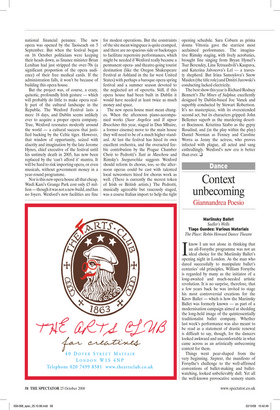Wexford winner
Tom Sutcliffe
The Irish government has spent €27 million on a stunning new opera house in Wexford, which is having a flawless and crisis-free baptism in the current opera festival there. The old Theatre Royal was knocked down in November 2005, and the money the festival managed to raise was just €6 million of the €33 million total building cost. But the architects Ciaran McGahon, from the Irish Office of Public Works, and the British theatre specialist Keith Williams have squeezed an almost 800-seat house on to the old site — expanded by the addition of the neighbouring area formerly occupied by the Wexford People newspaper printworks.
So the theatre is still right in the heart of the town, approached along the familiar narrow terraced streets, its tall flytower challenging the nearby Pugin spires. And the facilities backstage are grand, as they say, making the festival diet of three operas run in tandem no longer a miracle but just a strain, while the foyers into which the three tiers of seating flow are generous and comfortable and the bars on the upper floors offer sublime views out to the Irish Sea and around the countryside.
There is even a second small auditorium seating 175 which matches the stage acting area and doubles as a rehearsal space, while the bars also turn into rehearsal studios. The acoustic of the main house (masterminded by Arup), with orchestra pit lifts and adaptable baffles that can be finetuned, is as warm and musically perfect in the stalls as in the circle. The plenum-based air conditioning is totally silent, seats are of comfortable blue leather, and the auditorium is both lined and partly constructed with richly grained American black walnut wood — as are the foyers. The orchestra lifts can extend the forestage or enable extra seating for spoken theatre to stretch right up to the proscenium, bringing total capacity to 854.
One has to hail a brilliant achievement which matches, perhaps even challenges, the Glyndebourne experience — though Wexford is two thirds the size and extravagantly intimate. Ireland’s only purposebuilt opera house would be élitist if built in bustling commercially minded Dublin. But Wexford people will be proud of their treasure, as they should be at a time of national financial penance. The new opera was opened by the Taoiseach on 5 September. But when the festival began on 16 October politicians were keeping their heads down, as finance minister Brian Lenihan had just stripped the over-70s (a significant proportion of the opera audience) of their free medical cards. If the administration falls, it won’t be because of building this opera house.
But the project was, of course, a crazy, quixotic, profoundly Irish gesture — which will probably do little to make opera really part of the cultural landscape in the Republic. The Wexford Festival lasts a mere 18 days, and Dublin seems unlikely ever to acquire a proper opera company. True, Wexford resonates modestly around the world — a cultural success that justified backing by the Celtic tiger. However, that window of opportunity, seized with alacrity and imagination by the late Jerome Hynes, chief executive of the festival until his untimely death in 2005, has now been replaced by the ‘can’t afford it’ mantra. It will be hard to risk importing opera, or even musicals, without government money in a year-round programme.
Nor is this new opera house all that cheap. Wasfi Kani’s Grange Park cost only £5 million — though it was not a new-build, and has no foyers. Wexford’s new facilities are fine for modest operations. But the constraints of the site mean wingspace is quite cramped, and there are no spacious side or backstages to facilitate repertoire performances, which might be needed if Wexford really became a permanent operaand theatre-going tourist destination (like the Oregon Shakespeare Festival at Ashland in the far west United States) with perhaps a baroque opera spring festival and a summer season devoted to the neglected art of operetta. Still, if this opera house had been built in Dublin it would have needed at least twice as much money and space.
The new opera house must mean changes. When the afternoon piano-accompanied works (Suor Angelica and Il signor Bruschino this year, staged in Dun Mhuire, a former cinema) move to the main house they will need to be of a much higher standard. At last the festival has hired its own excellent orchestra, and the overacted feeble contribution by the Prague Chamber Choir to Pedrotti’s Tutti in Maschera and Rimsky’s Snegurochka suggests Wexford should reform its chorus, too, so the afternoon operas could be cast with talented local newcomers hired for chorus work as well. (There is currently the merest token of Irish or British artists.) The Pedrotti, musically agreeable but raucously staged, was a coarse Italian import to help the tight opening schedule. Sara Coburn as prima donna Vittoria gave the starriest most acclaimed performance. The imaginative Rimsky staging, with lively acrobatics, brought fine singing from Bryan Hymel’s Tsar Berendey, Lina Tetruashvili’s Kaupava, and Katerina Jalvocova’s Lel — a travesty shepherd. But Irina Samoylova’s Snow Maiden (the title role) and Dmitri Jurowski’s conducting lacked electricity.
The best show this year is Richard Rodney Bennett’s The Mines of Sulphur, excellently designed by Dublin-based Joe Vanek and superbly conducted by Stewart Robertson. It’s no masterpiece, with its overextended second act, but its characters gripped: John Bellemer superb as the murdering deserter Bocinnon. Krisztina Szabo as the gypsy Rosalind, and (in the play within the play) Daniel Norman as Fenney and Caroline Worra as Jenny the actress, who proves infected with plague, all acted and sang enthrallingly. Wexford’s new era is better than ever. ❑



















































































 Previous page
Previous page